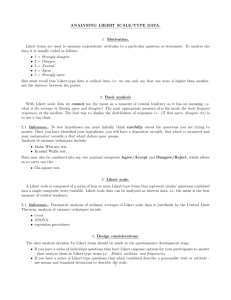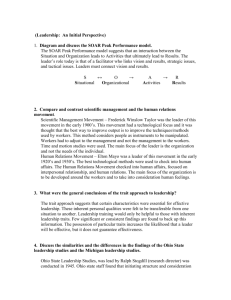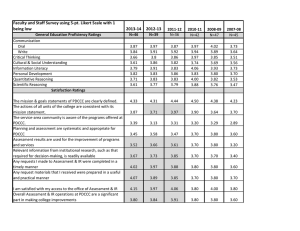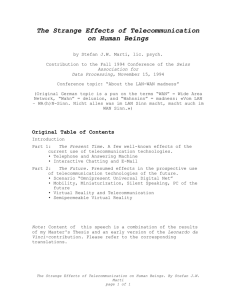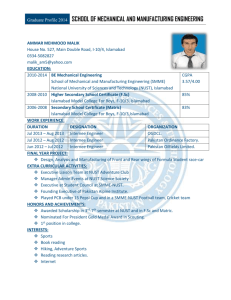Impact of Job Design on Organizational Commitment in Public
advertisement
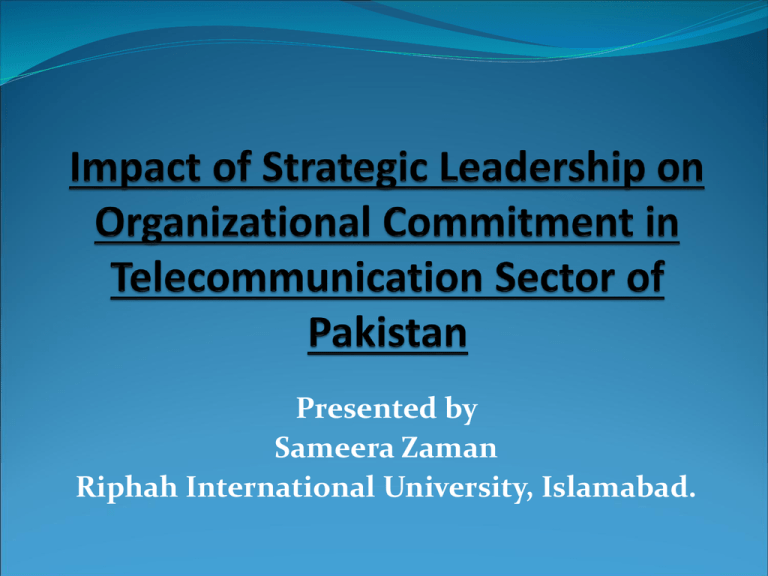
Presented by Sameera Zaman Riphah International University, Islamabad. Purpose The purpose of this research is to understand and find out the extent of strategic leadership and its impact on organizational commitment in telecommunication sector of Pakistan. Variables Independent variable Strategic leadership Dependent variable Organizational Commitment Strategic Leadership Strategic leadership relates an organization's ideologies, identity, mission and view of the macro environment system to it are differentiating core competencies” (Worden, 2003). A process of guidance that set a fresh strategy in work place is considered as strategic leadership (Nutt and Backoff, 1996). Maintaining the short term financial stability and improving the long term viability of the organization by influencing other to make day to day decision is known as strategic leadership (Rowe, 2001). The responsibility of the executive’s strategic leadership is to start change that will make the feasible future for the organization is the part of the definition of strategic leadership (Thomas, Schermerhorn, Dienhart, and Bartles, 2004). Organizational Commitment: The layman definition of organizational commitment is involvement and identification of an individual with an organization; this is the positive social relationship between an individual and organization. Organizational commitment is defined as ones’ strong belief and acceptance for organizational goals and desire and intention to maintain membership with organization (Dyne et al, 1995). Organizational subculture variables are the job satisfaction variables which are relate in the Maslow’s hierarchy and have the strongest relationship with the organizational commitment (Lok and Crawford, 1999). Research Model Hypothesis Strategic leadership is associated with Organizational commitment. Research Methodology Research Design Purpose Hypothesis Testing Type of Investigation Correlational Researcher Interference Minimal Study Setting Non Contrived/Field Study Unit of Analysis Individual Time Horizon Cross Sectional Research Methodology Questionnaire o o o o o Total 25 questions Dichotomous, Category and Likert Scales were used Personally administered Covering letter explaining the purpose All questions were to be answered anonymously Divided in to three Sections o o o Demographics ( Dichotomous & Category Scales) Strategic Leadership (1-5 Likert Scale) Organizational Commitment (1-5 Likert Scale) Research Methodology Population, Sample and Sampling Technique Different employees of telecommunication organization at Karachi, Lahore, Rawalpindi and Islamabad. Purposive Sampling Questionnaires Sent 150 Response received 132 Total respondent (88%) Result of Correlation Organizational Commitment Strategic Leadership Organizational Commitment 1 0.466** Strategic Leadership 0.466** 1 Result of Regression Models Strategic Leadership n = 132 Beta .466 T 6.010 R square = 0.217 Adjusted R square = 0.211 F =36.122 Sig. = 0.00 Dependent variable: Organizational Commitment Sig. .000 Discussion From the result it is found that strategic leadership is interrelated with the organizational commitment. Strategic leadership helps in the formulation and implication of strategy in the organization and helps in providing guideline. Strategic leadership is provided by the managers and chief executive officers. Formulation and implementation of the activities of leadership managing strategy are drives from the strategic decision (Shrivastava and Nachman, 1989). Discussion Strategic leaders also help employees to be successful by enhancing their productivity and encourage behaviors that will lead to better retention, superior job performance, and greater career satisfaction. The leaders who set their vision and the mission according the components of the professional leadership and easily motivate their follower for attain these goals and these employees are very satisfied with their jobs and are more committed with their organizations (Eddy, Lorenzet and Mastrangelo, 2008). Limitations Longitudinal Studies Other Antecedents More Outcomes Sector wise Analysis


